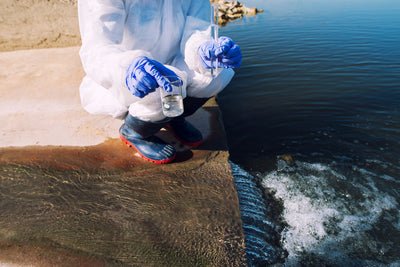EPA’s New PFAS Rule Does Not Address Drinking Water
RSS
Analies Dyjak, M.A. | Policy Nerd
The Environmental Protection Agency (EPA) has introduced a new rule regarding a category of common drinking water contaminants called Per and Polyfluoroalkyl Substances. The proposed final rule does not ban the production and distribution of PFAS chemicals, but provides an brief check for chemical manufacturers.
Why Is Chemical Pollution Problematic in the United States?
The United States has historically pushed products and chemicals to market without any sort of environmental or public health due diligence. Further, chemical manufacturers are not required to study how their products may impact human health before becoming available to the public. This includes a plethora of chemicals used in things like household cleaning products, solvents, fire suppressants, pesticides, and more. Typically a chemical manufacturing company gets served a lawsuit years after people become seriously ill after using or being exposed to their chemicals. In short, there are few barriers to entry when introducing a new product or chemical to market. The United States does not follow the “precautionary principle,” which is a commonly used method in European countries. The precautionary principle is a preventative check used to ensure the safety of a product before entering the market.
How Does This Affect Drinking Water?
Industrial and chemical pollution threaten drinking water more than almost any other type of pollution in the United States. You cannot see, taste, or smell most industrial pollutants - and most are so small that traditional municipal water treatment facilities are not able to remove them. Per and Polyfluoroalkyl Substances (PFAS) are believed to be one of the largest threats to drinking water in the United States. PFAS are a category of man-made contaminants that are believed to be ubiquitous in tap water. They are associated with the production of Scotch-Guard, Teflon, stain-repellent products, non-stick products, and more. This rule only puts a small barrier between PFAS pollution and contaminated drinking water, rather than an outright ban.
Health Effects Associated with PFAS Exposure:
All major U.S. health agencies agree that exposure to PFAS chemicals causes various negative health effects. This includes; The Environmental Protection Agency, The Centers for Disease Control, and The Food and Drug Administration. Health impacts identified by these agencies include:- Increased risk of miscarriages
- Increased risk of cancer
- Lowered immune function
- Thyroid hormone disruptions
- Low infant birth weight
Did EPA Go Far Enough?
Under the proposed rule, EPA will be required to review and approve the use of products that contain PFAS chemicals. This rule is being proposed under the Toxic Substance and Control Act (TSCA), which regulates the use of new and existing chemicals. It’s important that we are crystal clear in the breakdown of this rule: PFAS are still being manufactured and distributed in the United States, and will continue to be manufactured and distributed as a result of this proposed rule.
Why This Rule is Flawed:
The proposed rule still allows the manufacturing and distribution of new PFAS in the United States. This is a particularly important regulatory flaw because federal or state governments have not been able to implement a plan that addresses existing PFAS in the environment. Even worse, the proposed rule does not acknowledge drinking water as a potential exposure route. Although other rules and proposed rules acknowledge the problem, none provided by EPA present a clear protocol as to how to remove them from tap water.
Other Articles We Think You Might Enjoy:Why Do Military Bases Show High Levels of PFAS?
Yale: PFAS Associated With Increased Risk of Miscarriages
CDC: Possible Intersection Between PFAS and COVID-19




